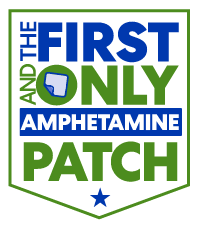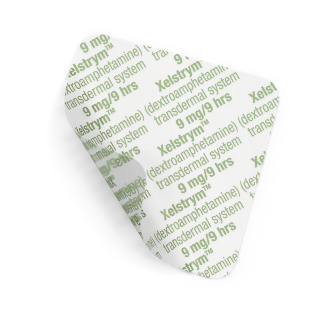
XELSTRYM: For adult patients seeking ADHD treatment who want to spend
Their time,Their way
You and your patients can work together to determine when to apply and when to remove the patch to align periods of symptom control with their daily routines




You and your patients can work together to determine when to apply and when to remove the patch to align periods of symptom control with their daily routines

XELSTRYM should be removed within 9 hours. Dose titration and final dosage should be individualized depending on clinical response and tolerability.1
An ADHD treatment that offers you and your patients scheduling flexibility
Formulated with dextroamphetamine, the active metabolite of Vyvanse®1†
Four dosage strengths, choice of 10 approved application sites, and a clear, discreet appearance1
Terms and conditions apply.
There are no head-to-head safety or efficacy studies comparing Vyvanse® and XELSTRYM.
VYVANSE® is a registered trademark of Takeda Pharmaceuticals U.S.A., Inc.
Reference: 1. XELSTRYM (dextroamphetamine) transdermal system, CII [package insert]. Miami, FL. Noven Therapeutics LLC. October, 2023.
XELSTRYM (dextroamphetamine) transdermal system, CII is indicated for the treatment of Attention Deficit Hyperactivity Disorder (ADHD) in adult and pediatric patients 6 years and older. Pediatric patients younger than 6 years of age experienced more long-term weight loss than patients 6 years and older.
IMPORTANT SAFETY INFORMATIONXELSTRYM has a high potential for abuse and misuse, which can lead to the development of a substance use disorder, including addiction. Misuse and abuse of CNS stimulants, including XELSTRYM, can result in overdose and death, and this risk is increased with higher doses or unapproved methods of administration, such as snorting or injection.
Before prescribing XELSTRYM, assess each patient’s risk for abuse, misuse, and addiction. Educate patients and their families about these risks, proper storage of the drug, and proper disposal of any unused drug. Throughout XELSTRYM treatment, reassess each patient’s risk of abuse, misuse, and addiction and frequently monitor for signs and symptoms of abuse, misuse, and addiction.
Risks to Patients with Serious Cardiac Disease: Avoid XELSTRYM use in patients with known structural cardiac abnormalities, cardiomyopathy, serious cardiac arrhythmia, coronary artery disease, or other serious cardiac diseases. Sudden death has been reported in patients with structural cardiac abnormalities or other serious cardiac disease who were treated with CNS stimulants at the recommended ADHD dosage.
Increased Blood Pressure and Heart Rate: CNS stimulants cause an increase in blood pressure (mean increase about 2 to 4 mm Hg) and heart rate (mean increase about 3 to 6 bpm). Monitor all patients for potential tachycardia and hypertension.
Psychiatric adverse reactions: Exacerbation of Pre-existing Psychosis : May exacerbate symptoms of behavior disturbance and thought disorder in patients with a pre-existing psychotic disorder. Induction of a Manic Episode in Patients with Bipolar Disorder : May induce a mixed/manic episode in patients. Prior to initiating XELSTRYM treatment, screen for risk factors for developing a manic episode (e.g., comorbid or history of depressive symptoms, or a family history of suicide, bipolar disorder, and depression). New Psychotic or Manic Symptoms : At recommended doses, may cause psychotic or manic symptoms (e.g., hallucinations, delusional thinking, or mania) in patients with no prior history of psychotic illness or mania. Discontinue XELSTRYM if symptoms occur.
Long-Term Suppression of Growth in Pediatric Patients: CNS stimulants have been associated with weight loss and slowing of growth rate in pediatric patients. Closely monitor growth (weight and height). Treatment may need to be interrupted in pediatric patients not growing or gaining weight as expected. XELSTRYM is not approved for use in pediatric patients below 6 years of age.
Peripheral Vasculopathy, including Raynaud’s Phenomenon: Stimulants, including XELSTRYM, are associated with peripheral vasculopathy, including Raynaud’s phenomenon. Signs and symptoms are usually intermittent and mild; very rare sequelae include digital ulceration and/or soft tissue breakdown. Careful observation for digital changes is necessary during treatment with stimulants. Further evaluation including rheumatology referral, may be appropriate for certain patients.
Serotonin Syndrome: Risk is increased when XELSTRYM is co-administered with serotonergic agents (e.g., SSRIs, SNRIs, triptans), and with CYP2D6 inhibitors. If it occurs, discontinue XELSTRYM and initiate supportive treatment.
Contact Sensitization: Use of XELSTRYM may lead to contact sensitization. Discontinue XELSTRYM if contact sensitization is suspected.
Application Site Reactions: During wear time or immediately after removal of XELSTRYM, local skin reactions such as pain, pruritus, burning sensation, erythema, discomfort, edema, and/or swelling were reported. Select a different application site each day to minimize skin reactions.
External Heat: Avoid exposing XELSTRYM to direct external heat sources during wear because both the rate and extent of absorption are increased.
Motor and Verbal Tics, and Worsening of Tourette’s Syndrome: Before initiating XELSTRYM, assess the family history and clinically evaluate patients for tics or Tourette’s syndrome. Regularly monitor XELSTRYM-treated patients for the emergence or worsening of tics or Tourette’s syndrome, and discontinue treatment if clinically appropriate. CNS stimulants, including methylphenidate, have been associated with the onset or exacerbation of motor and verbal tics. Worsening of Tourette’s syndrome has also been reported.
ADVERSE REACTIONSMost common adverse reactions (incidence ≥2% and greater than the rate for placebo) in pediatric patients 6 to 17 years treated with XELSTRYM were: decreased appetite, headache, insomnia, tic, abdominal pain, vomiting, nausea, irritability, increased blood pressure, and increased heart rate.
Most common adverse reactions (incidence of ≥5% and a rate at least twice placebo) in adults treated with lisdexamfetamine were: decreased appetite, insomnia, dry mouth, diarrhea, nausea, and anxiety.
PREGNANCY AND LACTATIONXELSTRYM may cause fetal harm. Breastfeeding is not recommended during XELSTRYM treatment.
Please click here for full Prescribing Information, including BOXED WARNING.
XELSTRYM (dextroamphetamine) transdermal system, CII is indicated for the treatment of Attention Deficit Hyperactivity Disorder (ADHD) in adult and pediatric patients 6 years and older. Pediatric patients younger than 6 years of age experienced more long-term weight loss than patients 6 years and older.
IMPORTANT SAFETY INFORMATIONXELSTRYM has a high potential for abuse and misuse, which can lead to the development of a substance use disorder, including addiction. Misuse and abuse of CNS stimulants, including XELSTRYM, can result in overdose and death, and this risk is increased with higher doses or unapproved methods of administration, such as snorting or injection.
Before prescribing XELSTRYM, assess each patient’s risk for abuse, misuse, and addiction. Educate patients and their families about these risks, proper storage of the drug, and proper disposal of any unused drug. Throughout XELSTRYM treatment, reassess each patient’s risk of abuse, misuse, and addiction and frequently monitor for signs and symptoms of abuse, misuse, and addiction.
Risks to Patients with Serious Cardiac Disease: Avoid XELSTRYM use in patients with known structural cardiac abnormalities, cardiomyopathy, serious cardiac arrhythmia, coronary artery disease, or other serious cardiac diseases. Sudden death has been reported in patients with structural cardiac abnormalities or other serious cardiac disease who were treated with CNS stimulants at the recommended ADHD dosage.
Increased Blood Pressure and Heart Rate: CNS stimulants cause an increase in blood pressure (mean increase about 2 to 4 mm Hg) and heart rate (mean increase about 3 to 6 bpm). Monitor all patients for potential tachycardia and hypertension.
Psychiatric adverse reactions: Exacerbation of Pre-existing Psychosis : May exacerbate symptoms of behavior disturbance and thought disorder in patients with a pre-existing psychotic disorder. Induction of a Manic Episode in Patients with Bipolar Disorder : May induce a mixed/manic episode in patients. Prior to initiating XELSTRYM treatment, screen for risk factors for developing a manic episode (e.g., comorbid or history of depressive symptoms, or a family history of suicide, bipolar disorder, and depression). New Psychotic or Manic Symptoms : At recommended doses, may cause psychotic or manic symptoms (e.g., hallucinations, delusional thinking, or mania) in patients with no prior history of psychotic illness or mania. Discontinue XELSTRYM if symptoms occur.
Long-Term Suppression of Growth in Pediatric Patients: CNS stimulants have been associated with weight loss and slowing of growth rate in pediatric patients. Closely monitor growth (weight and height). Treatment may need to be interrupted in pediatric patients not growing or gaining weight as expected. XELSTRYM is not approved for use in pediatric patients below 6 years of age.
Peripheral Vasculopathy, including Raynaud’s Phenomenon: Stimulants, including XELSTRYM, are associated with peripheral vasculopathy, including Raynaud’s phenomenon. Signs and symptoms are usually intermittent and mild; very rare sequelae include digital ulceration and/or soft tissue breakdown. Careful observation for digital changes is necessary during treatment with stimulants. Further evaluation including rheumatology referral, may be appropriate for certain patients.
Serotonin Syndrome: Risk is increased when XELSTRYM is co-administered with serotonergic agents (e.g., SSRIs, SNRIs, triptans), and with CYP2D6 inhibitors. If it occurs, discontinue XELSTRYM and initiate supportive treatment.
Contact Sensitization: Use of XELSTRYM may lead to contact sensitization. Discontinue XELSTRYM if contact sensitization is suspected.
Application Site Reactions: During wear time or immediately after removal of XELSTRYM, local skin reactions such as pain, pruritus, burning sensation, erythema, discomfort, edema, and/or swelling were reported. Select a different application site each day to minimize skin reactions.
External Heat: Avoid exposing XELSTRYM to direct external heat sources during wear because both the rate and extent of absorption are increased.
Motor and Verbal Tics, and Worsening of Tourette’s Syndrome: Before initiating XELSTRYM, assess the family history and clinically evaluate patients for tics or Tourette’s syndrome. Regularly monitor XELSTRYM-treated patients for the emergence or worsening of tics or Tourette’s syndrome, and discontinue treatment if clinically appropriate. CNS stimulants, including methylphenidate, have been associated with the onset or exacerbation of motor and verbal tics. Worsening of Tourette’s syndrome has also been reported.
ADVERSE REACTIONSMost common adverse reactions (incidence ≥2% and greater than the rate for placebo) in pediatric patients 6 to 17 years treated with XELSTRYM were: decreased appetite, headache, insomnia, tic, abdominal pain, vomiting, nausea, irritability, increased blood pressure, and increased heart rate.
Most common adverse reactions (incidence of ≥5% and a rate at least twice placebo) in adults treated with lisdexamfetamine were: decreased appetite, insomnia, dry mouth, diarrhea, nausea, and anxiety.
PREGNANCY AND LACTATIONXELSTRYM may cause fetal harm. Breastfeeding is not recommended during XELSTRYM treatment.
Please click here for full Prescribing Information, including BOXED WARNING.